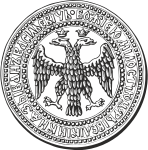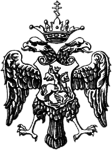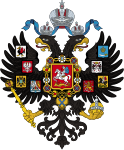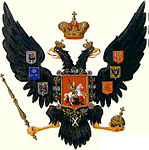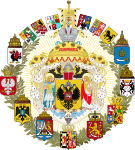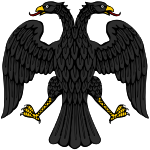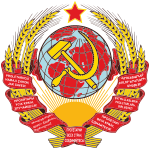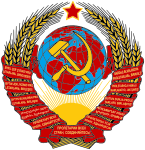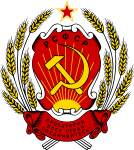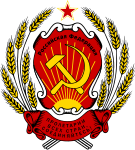Coat of arms of Russia
This article needs additional citations for verification. (November 2011) |
You can help expand this article with text translated from the corresponding article in Russian and Russian. (July 2022) Click [show] for important translation instructions.
|
| Coat of arms of Russia | |
|---|---|
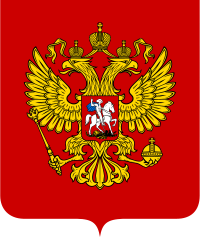 | |
| Versions | |
 | |
Shield | Gules, a double-headed eagle displayed, twice imperially crowned, grasping in the dexter claw an imperial sceptre, and in the sinister claw an imperial orb, all Or; in chief another larger imperial crown with issuant and pendent therefrom a ribbon, also Or; the eagle is charged on the breast with an escutcheon Gules, Saint George slaying the dragon. |
The coat of arms of Russia derives from the earlier
Description and usage
The two main elements of Russian state symbols (the two-headed eagle and Saint George slaying the dragon) predate Peter the Great. According to the Kremlin's website:[2][3]
«...четырёхугольный, с закруглёнными нижними углами, заострённый в оконечности красный геральдический щит с золотым двуглавым орлом, поднявшим вверх распущенные крылья. Орел увенчан двумя малыми коронами и — над ними — одной большой короной, соединенными лентой. В правой лапе орла — скипетр, в левой — держава. На груди орла, в красном щите, — серебряный всадник в синем плаще на серебряном коне, поражающий серебряным копьём черного опрокинутого навзничь и попранного конём дракона.»
Which is translated as:
"… a gold two-headed eagle with raised extended wings set against a four-cornered red heraldic shield with rounded lower corners. Two small crowns top the eagle's heads, with one large crown above them. The three crowns are linked by a ribbon. The eagle holds a sceptre in its right claw and an orb in its left claw. The eagle bears a red shield on its breast depicting a silver horseman in a blue cape, mounted upon a silver horse and slaying a black dragon with a silver spear."
The current coat of arms was designed by artist

Today, the imperial crowns on each head stand for the unity and sovereignty of
It appears on the federal buildings and is on the cover of the national passport.
The standard of the president of Russia is a squared Russian tricolour defaced with the coat of arms of Russia, the banner of the Russian Armed Forces also has the coat of arms centered on the obverse side. Some state awards of Russia are also designed based on the coat of arms, including the State Prize. Russian ruble coins depict the coat of arms on the obverse side since 2016.
Historical versions
The heraldic device of Russia has gone through three major periods in its history, undergoing major changes in the transitions between the
The other main Russian coat of arms, the image of St George slaying the dragon, is contemporaneous. In its first form, as a rider armed with a spear, it is found in the seal of
After the assumption of the title of
1721–1917: Russian Empire
| Coat of arms of the Russian Empire | |
|---|---|
 | |
| Versions | |
 Greater achievement | |
 Middle achievement | |
 Lesser
achievement | |
Michael and Gabriel | |
| Compartment | Vegetal |
| Order(s) | Order of St. Andrew |
The
Its central element is the state coat of arms, surmounted with the helmet of
Around the central composition are placed fifteen coats of arms of the various territories of the Russian Empire. Nine of these are crowned and placed on a laurel and oak wreath. Proceeding from the left in a counter-clockwise direction, these represent, as they are included in the
The six upper escutcheons are joint depictions of various smaller principalities and .
The Middle Coat of Arms (Средний государственный герб Российской Империи) is similar to the Great Coat of Arms, excluding the
In the beginning of the 17th century, with the ascension of the
During the reign of
During the early 19th century, the eagle designs diversified, and two different variants were adopted by Emperor Nicholas I. The first type represented the eagle with spread wings, one crown, with an image of St.George on the breast and with a wreath and a thunderbolt in its claws. The second type followed the 1730 pattern, with the addition of the arms of Kazan, Astrakhan and Siberia on its left wing and those of Poland, the Taurica and Finland on the right one.
In 1855–57, in the course of a general heraldic reform, the eagle's appearance was changed, mirroring German patterns, while St George was made to look to the left, in accordance with the rules of Western heraldry. At the same time, the full set of coat of arms of Great, Medium and Minor Arms, was laid down and approved. The final revisions and changes were made in 1882–83, and are those described above.
1918–93: Soviet and post-Soviet Russia
The coat of arms of the Russian Soviet Federative Socialist Republic (RSFSR) was adopted on 10 July 1918 by the government of the Russian Soviet Federative Socialist Republic (Soviet Union), and modified several times afterwards. It shows wheat as the symbol of agriculture, a rising sun for the future of the Russian nation, the red star (the RSFSR was the last Soviet Republic to include the star in its state emblem, in 1978) as well as the hammer and sickle for the victory of Communism and the "world-wide socialist community of states".
The
The acronym of the RSFSR is shown above the hammer and sickle, and reads 'PCФCP', for "Российская Советская Федеративная Социалистическая Республика" (lit. 'Russian Soviet Federative Socialist Republic').
Similar emblems were used by the
The
The emblem shows the Soviet emblems of the Hammer and Sickle and the Red Star over a globe, in the center of a wreath wrapped in ribbons emblazoned with the communist motto ("Workers of the world, unite!") in the
Four versions were used: 6 ribbons were used in 1923, which were written on in Russian, Ukrainian, Belarusian, Georgian, Armenian, and Azerbaijani; 11 ribbons with the addition of Turkmen, Uzbek, Tajik, Kazakh, Kyrgyz; 16 with the addition of Estonian, Latvian, Lithuanian, Moldavian, and Finnish. Finally, the inscriptions in Azerbaijani, Turkmen, Uzbek, Tajik, Kazakh and Kyrgyz were updated to reflect their transition from the Latin to the Cyrillic script. The final version of the emblem was adopted in 1956 with the removal of the Finnish inscription from the insignia, reflecting the 1956 transformation of the Karelo-Finnish SSR into the Karelian ASSR.
In 1992, the inscription was changed from RSFSR ('РСФСР') to the Russian Federation ('Российская Федерация') in connection with the change of the name of the state.[5] In 1993, president Boris Yeltsin signed a decree to replace the Communist design by the present coat of arms.[6][7]
Evolution
-
1472: Seal of
Ivan III the Great -
1539: Seal of
Ivan IV the Terrible -
1577: Coat of arms
under Ivan IV -
1589: Coat of arms
under Feodor I -
1667: Coat of arms of the Tsardom of Russia
-
1721: Petrovian era coat of arms
-
1800: Greater
coat of arms -
1802: Lesser coat of arms
-
1825: First variant of Nicholas I's coat of arms
-
1830: Second variant of the coat of arms
-
1882: Greater
coat of arms -
1918: Coat of arms of the Russian State
-
1918: 1st coat of arms of the Russian SFSR
-
1920: 2nd coat of arms of the Russian SFSR
-
1923: 1st coat of arms of the Soviet Union
-
1929: 2nd coat of arms of the Soviet Union
-
1936: 3rd coat of arms of the Soviet Union
-
1946: 4th coat of arms of the Soviet Union
-
1954: 3rd coat of arms of the Russian SFSR
-
1956: 5th coat of arms of the Soviet Union
-
1978: 4th coat of arms of the Russian SFSR
-
1991: Coat of arms after the dissolution of the Soviet Union
-
1993: Present
coat of arms -
1993: Present
coat of arms (other variant)
See also
- Armorial of Russia
- Coat of arms of Moscow
- Coat of arms of Saint Petersburg
- Russian heraldry
- Flag of Russia
References
- ISBN 9780429026263.
- ^ "Герб". Kremlin.ru (in Russian). Retrieved 2020-06-02.
- ^ "National Coat of Arms". Kremlin.ru. Retrieved 2020-06-02.
- ^ Ivanov, Dmitry. "Geral'dika segodnya || Yevgeny Il'ich UKHNALYOV (1931–2015)" Геральдика сегодня || Евгений Ильич УХНАЛЁВ (1931–2015) [Heraldry today || Evgeny Ilyich UHNALYOV (1931–2015)]. sovet.geraldika.ru. Retrieved 2018-02-12.
- ^ The law of the Russian Federation from 21 April 1992 № 2708-I «About changes and additions of the Constitution (Basic law) of the Russian SFSR»
- ^ "Is This the Symbol Russia Wants? : Yeltsin chooses the particularly inapt double-headed eagle. Why?". Los Angeles Times. 6 December 1993. Retrieved 7 December 2022.
- ^ Khutarev, Vladimir (13 July 2014). "From Byzantium to present-day Russia, the double-headed eagle still soars". Russia Beyond. Retrieved 7 December 2022.
External links
- (in Russian) Heraldry of the Russian Empire
- (in Russian) The Code of Principal Laws of the Russian Empire (Свод Основных Государственных Законов, 1906) (archived 29 September 2007)


